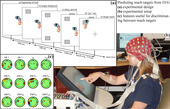Highlight
Extracting Reach Direction from EEG Before the Reach
Achievement/Results
NSF funded researchers Paul Hammon, Virginia de Sa, Howard Poizner, Scott Makeig, and Emo Todorov at the University of California, San Diego have recently discovered that they can predict people’s intended reach direction by externally recording their brain waves. The researchers recorded brain activity externally using electroencephalography (EEG) and were able to predict the planned reach direction even before the person started to move. This is the first demonstration of decoding targets of planned natural reaches from the non-invasively recorded EEG. The planned reach direction was decoded using sophisticated signal processing and machine learning technology. This was particularly necessary to remove movement artifacts (such as eye movements) that contaminate the EEG signal. These results lay the foundation for future EEG-based brain-computer interfaces where the machine-interpreted EEG signal of movement impaired individuals could be used to replace direct muscle activation. The decoded EEG signal could then be used to activate a computer keyboard, mouse or robotic arm or wheelchair. The developed algorithms can also be used to examine the change in EEG activity during motor learning. Paul Hammon is an NSF IGERT (Integrative Graduate Education and Research Traineeship) fellow in the Vision and Learning in Humans and Machines Traineeship program at UCSD run by Professors Virginia de Sa and Garrison Cottrell. This is an example of using machine learning to improve human imaging and to improve our knowledge of human learning. This work was reported in IEEE Signal Processing Magazine.
Address Goals
This is the first example of decoding planned reach direction from EEG and has great potential importance for understanding more about motor planning , processing, and learning (and more general EEG signals) as well as for the development of non-invasive Brain Computer Interfaces. The overall algorithm used has the potential to become important research infrastructure for those working with EEG.






